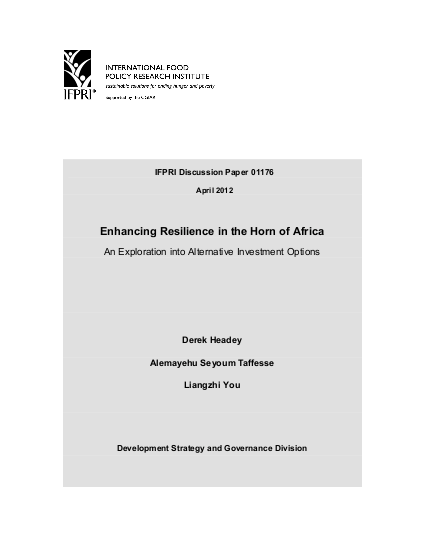
The most recent (2010-211) drought in the arid and semiarid lowlands (ASAL) of the Horn of Africa has rendered over 13 million people in need of food, and caused a devastating famine in southern Somalia. The drought has also raised concerns that pastoralist livelihoods in this region are no longer viable or sustainable, thereby justifying strategies that aim to sedentarize and diversify these livelihoods. Countering this view are advocates of wholesale protection of pastoralist livelihoods. Yet despite these very contrasting views on economic development in the region, very little research directly addresses this big picture question of where public resources should be invested. In this paper we argue that both economic theory and the existing evidence base warrant a more balanced development strategy involving movement out of pastoralism (intersectoral transformation), modernization of pastoralism (intrasectoral transformation), and cross-cutting transformations of the demographic, social, and political structure of ASAL populations. We then explore the empirical basis for balancing investments across these kinds of transformations. While the available evidence base is weak in some respects, we find that most nonpastoralist livelihoods in ASAL yield lower incomes than pastoralism, with the exception of urban livelihoods and irrigated farming. However, both irrigation and urban migration have a limited capacity to absorb growing populations. Additional irrigation investments in pastoralist regions, for example, appear to be capable of profitably absorbing only about three percent of the estimated pastoralist population in 2020. Migration is more promising, but only provided that it comes on the back of much larger investments in education and meaningful urban job opportunities. Being the dominant livelihood for the foreseeable future, and potentially quite a profitable one given growing demand for livestock products, pastoralism therefore needs to be an important component of local and regional development strategies. The goal of livestock investments should be to transform the pastoralist sector into a more profitable, more integrated, and more resilient economic system. The basis for achieving this transformation comprises a number of overlapping and largely reinforcing investments: (1) commercializing pastoralism with the goal of improving the competitiveness, value addition, poverty impact and outreach of livestock markets; (2) improving natural resource management; (3) economic diversification, but in a manner that is compatible with existing pastoralist livelihoods; (4) improved social infrastructure (pertaining to health, nutrition, and education); (5) improved physical infrastructure (principally roads, mobile telephony, and irrigation where profitable); (6) more effective disaster risk management strategies; and (7) a range of governance efforts, including efforts at better protection of pastoralist property rights, strengthening of conflict resolution mechanisms, and further efforts to promote bottom-up policymaking. While these arguments are grounded in economic theory and in the available evidence, our concluding section notes that this evidence is rather weak on many fronts, including basic statistics on human and livestock population, as well as more complex issues of carrying capacity. Building a better strategy for ASAL regions therefore requires a coordinated but interdisciplinary research program that can systematically pick up the various pieces of the pastoralist puzzle. This research should not only answer the crucially important questions of how to balance investments across livestock and nonlivestock sectors, but also involve rigorous evaluation of on-the-ground demonstrations trialing innovative methods of service delivery that overcome the severe constraints of isolation, mobility, and extreme vulnerability to climatic shocks.
